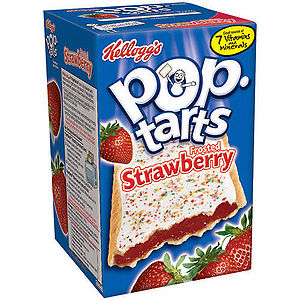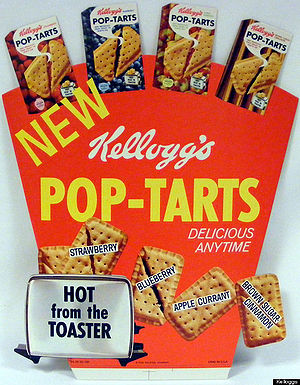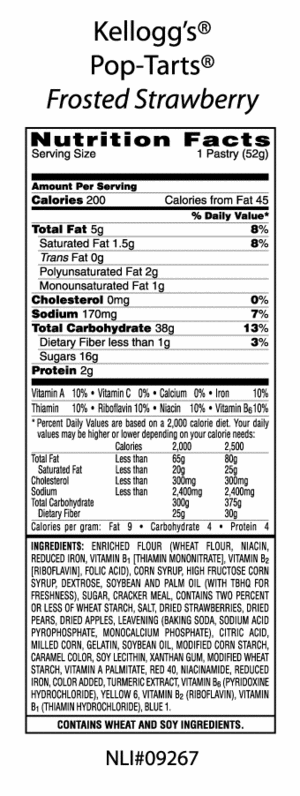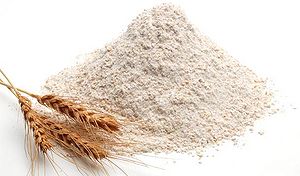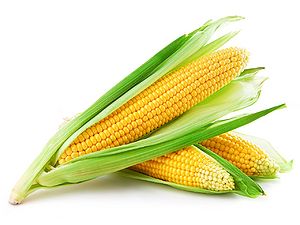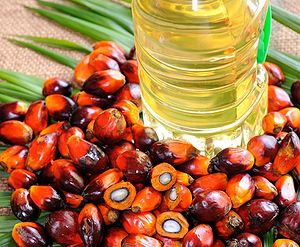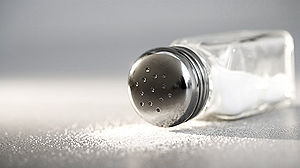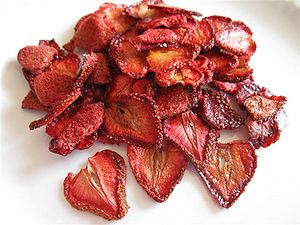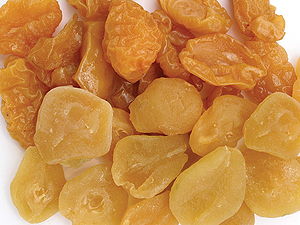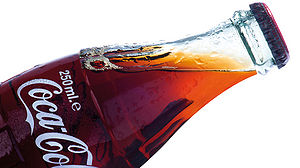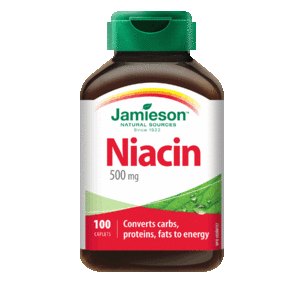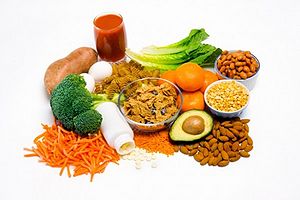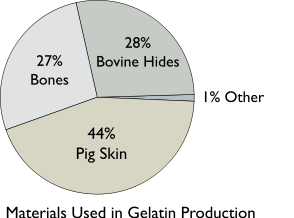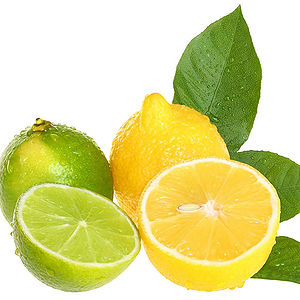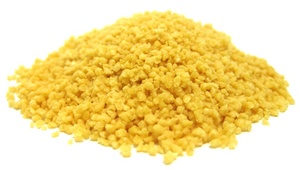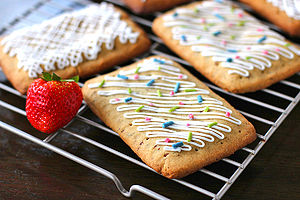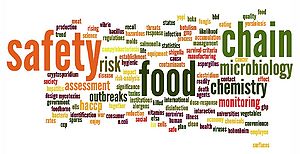Course:FNH200/2014w Team01 Poptarts
Pop-Tarts. What are they? As a child, you might have been familiar with these sugary treats. Found in grocery stores in almost every continent, Pop-Tarts are enjoyed by many as a tasty snack. In fact, over 1 billion Pop-Tarts are made and consumed every year[1]! It’s unquestionable that these pastries are popular and enjoyed by a large variety of people.
In today’s market, consumers are increasingly driven and motivated to make sensible lifestyle choices in their diet. Movements against processed and fast-foods, GMOs, and products containing certain chemicals have changed the landscape of the food industry forever. Many consumers are avoiding foods high in fat and carbohydrates. Although some dietary practices are based on misinformation, such as the practice of avoiding products with ingredients that sound like chemicals or toxins (when in reality they are safe agents used for specific purposes), it is valid to say that in general, consumers are moving toward healthier options in terms of food choices for themselves and their family.
Where do Pop-Tarts fit into this equation? With over 40 ingredients[2]for such a seemingly simple treat, many question whether this product is appropriate to enjoy. Ingredients such as pyridoxine hydrochloride and TBHQ may scare the more discerning and critical consumer. Do these products contain real fruit? What is the purpose of all those added ingredients one would never find in a home-cooked version of a toaster pastry? Are these ingredients even safe? In this presentation, we aim to inform you, the consumer, about everything related to Pop-Tarts, with a primary focus on the lesser-known chemicals and ingredients, examining their purpose, safety, and suitability. We hope that after reading this article, you will be able to make an informed and health-conscious decision on whether Pop-Tarts are, firstly, safe to eat, and secondly, whether they have any place in a well-balanced diet.
History
Technology for packaging dog food without refrigeration lead to the idea of the toaster strudel: a food commodity which could be stored in a thin aluminum package in cupboards, to be taken out at will and toasted. This guaranteed convenience for the consumer, which, along with its delectable flavour, fashioned an immediately popular product. The first toasted strudels were created by a company called Post, whose product was called “Country Squares”. Kellogg’s introduced Pop Tarts[3] in 1964 (they were initially going to be named “Fruit Scone”, but inspirations from Andy Warhol spurred change in proposal). Originally, there was a crease along the strudel so after toasting, they would be split diagonally. They also only existed in four flavours: strawberry, blueberry, apple currant, and brown sugar-cinnamon. Frosted pop tarts were launched in 1967 with an additional four flavours. [4]
By the 1990’s, Pop Tarts were Kellogg’s top selling product. Since 1982, profit generated from pop tarts has increased every year. Currently, Kellogg’s offers over 28 different varieties of pop tarts, along with many promotional and seasonal flavours popping in and out of shelves over the years. Despite this overwhelmingly large assortment, brown sugar-cinnamon pop tarts are the most popular, with frosted strawberry falling just behind.
Frosted Strawberry, the flavor covered in this article, was Kellogg's original Pop Tart flavor.
Ingredients
Essential Ingredients
These ingredients are the first few items listed in the ingredients list in Strawberry Frosted Pop Tarts, and by definition, represent the components present in the greatest quantities in the product. Some form the building blocks of the pastry itself, while others are the key component of the filling and frosting. These ingredients are common to almost all processed baked goods and pastries.
Enriched Flour
Enriched flour is flour containing specific restored nutrients that have been lost while being prepared. These nutrients include iron and B Vitamins (folic acid, riboflavin, niacin, and thiamine)[5].The goal of enriching flour is to restore the nutrients in the flour to match the nutritional status of the unrefined flour. These vitamins and minerals all play critical functions in the human body. B vitamins for example, are required by the body for metabolism, nerve function and hormone production. However, the fiber in enriched flour is also stripped away during processing. Therefore, it results in a relatively low fiber content which may not be optimal since fiber plays an important role in the digestive system and maintaining normal cholesterol levels. In Pop Tarts, enriched flour is the first ingredient on the ingredient list, meaning that it is present in the largest quantity in the food product out of all the other food ingredients. Without extra added fiber in Pop Tarts, this leaves them with a low fiber content, which maybe be a concern to some consumers.
Corn Syrup
Corn Syrup is made from starch of maize and it contains maltose and higher oligosaccharides. It is commonly used in foods to add extra volume, prevent sugar crystallization, and achieve desirable texture[6]. Corn syrup is different from high-fructose corn syrup; it is less processed and less sweet due to the higher level of fructose in high-fructose corn syrup. Corn syrup is added in Pop Tarts mainly due to its properties of enhancing texture and sweetness, and prevent sugar crystallization. However, corn syrup has a low nutritional value, and is one of the ingredients present in greatest quantities in Pop Tarts.
High Fructose Corn Syrup
High fructose corn syrup (HFCS) is derived from corn syrup. To produce high fructose corn syrup, corn syrups have to undergo enzymatic processing, converting part of the existing glucose into fructose to produce an enhance sweetness[7]. High fructose corn syrup is inexpensive compare to sucrose, therefore, it is mostly used in processed foods such as Pop Tarts. It contains either 42 percent or 55 percent fructose. The 42 percent strength is used in processed foods, such as Pop Tarts. Other than being an inexpensive ingredient, it is also extremely sweet which is used in Pop Tarts to enhance the flavor and help achieve the desirable sweetness. HFCS has received a lot of attention in the media and popular culture as being a potential health hazard. However, there is no evidence to support that HCFS is more dangerous than regular table sugar (sucrose).
Dextrose
Dextrose is derived from starches, and it is a form of glucose that is commonly used in packaged food due to its wide availability and low cost. Since dextrose has a sweet flavor, it is used in Pop Tarts and other desserts as an added sugar to enhance the sweetness. Dextrose is a type of sugar, and as with all other simple carbohydrates, consuming too much sugar can cause weight gain since it is high in calorie and lacks nutrients. Furthermore, sugars are one of the major causes of tooth decay, high blood pressure, and can lead to a higher risk of type 2 diabetes[8].
Soybean and Palm Oil
Soybean oil is a type of vegetable oil extracted from the seeds of soy bean. It Is one of the most widely used cooking oils. When producing soybean oil, Soy beans are heated to between 60 and 88ºC, causes the formation of hydrogenated oil which is also known as trans fats[9]. However, trans fats has been known to be a major risk factor of heart diseases and stroke. Palm oil is an edible vegetable oil derived from mesocarp of the oil palms. It is high in beta-carotene, therefore, it has a reddish color. Soybean and palm oil are both cooking oils used in Pop Tarts to tenderize the product by weakening the gluten bonds within the structure, and provide help to move heat through the product, perpetuating the baking process. However, since oil are fats which are high in calories, and trans fats may cause harmful health effects, these ingredients should be consumed in moderation.
Partially Hydrogenated Soybean Oil
Soybean oil is a product with minimal flavour or scent, so its function in processed foods such as Pop Tarts is to enhance other flavours and contribute pleasurable textures.[10] This type of oil is used as an alternative to other varieties because soybean is a primary food source for many livestock and it is therefore grown year round. Since it is always abundant and in demand, this allows it to be economically sensible so its usage in foods can provide its benefits without greatly affecting the cost of its respective products, including inexpensive pop tarts.[11] As soybean oil is naturally a liquid-like substance, partial hydrogenation is a process whereby hydrogen is forced into a system at high pressure to saturate (incompletely) fatty-acid chains with hydrogen bonds, thus forming a semi-solid product. Not only does this increase the stability of the oil, but it also lowers its melting point, allowing it to be heated at higher temperatures safely.[12] This is especially important in foods such as pop tarts, because its permits high thermal processing which is key to their production.
TBHQ is an antioxidant added to the soybean and palm oil as a preservative. It will be discussed in a section below.
Leavening Agents
Leavening agents are commonly used in baked goods to help make the dough rise, improving the consistency of the product. In home baking, one might use baking soda (sodium bicarbonate) or baking powder (a combination of baking soda and monocalcium phosphate). In Pop Tarts, three ingredients together perform this important function.
Baking Soda
Baking soda, or sodium bicarbonate, is commonly found in households. A fine white powder, baking soda is a leavening agent. As a base, it quickly reacts with acids in the pastry, resulting in release of carbon dioxide[13]. This escaping gas causes the dough to expand, allowing it to rise.
Sodium Acid Pyrophosphate
Sodium acid pyrophosphate is a white powder that also serves as a leavening agent. When combined with sodium bicarbonate, it produces carbon dioxide gas. It is usually only used in sweet products such as Pop Tarts as the phosphate component gives it an off-taste[14].
Monocalcium Phosphate
This ingredient is also used to help baked goods rise. The rising effect is caused by carbon dioxide produced by combination of monocalcium phosphate and sodium bicarbonate.
Flavors and Food Coloring
Salt
Each Frosted Strawberry pastry contains 170 milligrams of sodium, equal to 7% of the daily recommended intake[15]. Salt, or sodium chloride, is used for a variety of reasons in food products. It is well-known for imparting a salty taste, and enhancing the flavors of food products through modification of enzymatic activity. However, particularly in processed foods, salt is used as a preservative and an anti-microbial agent. Sodium chloride exerts its effect by reducing water activity, limiting the growth of microorganisms and chemical reactions that deteriorate food. Without salt, a Pop-Tart would likely taste different and have a reduced shelf-life due to the absence of these preservative and anti-microbial effects.
According to Health Canada, the daily recommended maximum intake for sodium is 2,300 milligrams per day for individuals 14 years of age and up[16]. Sodium is necessary for our bodies to function, but excess consumption can lead to health problems such as hypertension (high blood pressure). For these reasons, Health Canada has also made an Adequate Intake (AI) value, or “target level” of sodium to be consumed per day. For most adults, this is 1,500 milligrams per day[17]. We already know from the nutrition facts table that the sodium in a single Frosted Strawberry Pop-Tart constitutes 7% (7.4% exactly) of the maximum, or 11.3% of the AI value. Though this may not seem like much, one pastry represents about one-tenth of the amount of sodium one should ingest per day. This is especially important to consider for individuals on a low-sodium diet or those taking medications to control their high blood pressure or other heart conditions.
Dried Strawberries
These are strawberry pastries after all! Though it is quite disappointing that strawberries are found in a quantity of less than 2% of the final product[18], they are there – in dried form. Dried strawberries are used instead of fresh strawberries to extend the shelf-life of the product. Dried strawberries have a much lower water activity compared to fresh strawberries, allowing for reduced enzymatic reactions that would deteriorate the texture and quality of the fruit, as well as inhibiting microbial growth.
Dried Pears
It looks like strawberries aren’t the only fruit in this package! Dried pears and apples are most likely used as a cheap fruit alternative to make the filling. By adjusting the proportions of strawberries, pears, and apples, the exact texture and flavor of the filling can be made.
Dried Apples
See above, “Dried Pears” for an explanation.
Colour Added
The FDA has stated that is not required to be specifically indicated on product packaging. When questioned, Kellogg's stated that the color added in their ingredients is titanium dioxide[19], used in small amounts as a whitening agent for the frosting. Little is known about this ingredient in food and some groups claim that it should not be used until the full implications of this ingredient on long term health are known. Some food companies, such as Dunkin’ Donuts, have agreed to remove this ingredient from their products. Titanium dioxide is also found in skin products such as sunscreen and makeup but has no real health concerns in this capacity, as it is not absorbed into the skin.
Turmeric Colour
Tumeric spice is a natural spice added in trace amounts to provide a yellow-orange colour in food. As it is used in small trace amounts, it does not affect taste nor nutritional value[20]. This specific coloring is used in the strawberry flavored Pop-Tart and can also be found in some cheeses, yogurts and margarine.
Red #40
Red #40 is the most popular form of red coloring used in the US in production of food, drugs and skin care products. It is also commonly known as Allura Red. Found in a salt form that is soluble in water, this it can be conveniently added in wet ingredients when baking[21]. Allura Red is used in strawberry Pop-Tarts to provide it with the specific coloring. This specific coloring has generated some controversy in European countries where it is banned for children consumption due to associated health risks. Some studies have shown that consumption of Allura Red leads to symptoms of hypersensitivity in some individuals, such as hives.
Caramel Colour
Caramel colour does not contribute flavour to pop tarts; it exists solely for colouring purposes. It is produced from heat treatments of carbohydrates in conjunction with additional treatments of one of the following: acids, alkalis, sulphite-containing compounds, ammonium compounds, or ammonium-containing and sulphite-containing compounds. In pop tarts, caramel colour contributes to the aesthetic qualities of the product.[22]
Vitamins, Minerals, and Trace Elements
Most consumers are familiar with vitamins and minerals. Present in small amounts in almost all foods, vitamins and minerals play critical roles in the human body. Some work as cofactors in important metabolic pathways in the body, while others contribute to processes such as bone growth and regulation. In addition, some vitamins cannot be made by the human body, and thus require supplementation from foods to meet the need. In this section, the vitamins, minerals, and trace elements found inside Pop Tarts will be listed, along with a brief explanation of their source and function.
Vitamin A Palmitate
Vitamin A palmitate, also known as retinyl palmitate, is a readily digestible source of Vitamin A that’s naturally occurring in eggs, and whole milk[23]. It can also be synthetically produced and used to fortify foods during production such as in cheese and butter. It is added in small amounts in the production of Pop-Tarts to increase the nutritional value of their products. There is no health concern to those who consume Pop-Tarts but high levels of vitamin A palmitate can be toxic and result in symptoms such as vomiting and headaches.
Niacin/Niacine
This is a form of vitamin B3, found in many foods including yeast, eggs, meat, fish, milk, cereal grains, green vegetables and beans[24]. Found in many vitamin B complex supplements, Niacin is used in treatment of high cholesterol and along with other treatments used for circulation problems, migraine headache, dizziness and to reduce diarrhea associated with cholera, it is also used to prevent positive urine drug screens in people who take illegal drugs. Niacin when taken in great amounts in the body is converted to niacinamide, both are easily dissolved in water and are well absorbed when taken by mouth. Niacin is required for the proper function of fats and sugars in the body and maintains healthy cells. The deficiency of Niacin in the body can cause a condition known as pellagra common in the twentieth century and its symptoms include skin irritation, diarrhea, and dementia. Niacin is Likely safe for most people when taken by mouth, with the side effects of a flushing reaction, stomach upset, intestinal gas, dizziness and pain in the mouth but when taken in doses over 3 grams per day serious side effects may result like liver problems, gout, ulcer of the digestive tract, loss of vision, high blood sugar, irregular heartbeat and other serious problems.
The daily recommendation dietary allowance of niacin in Canada: for children 1-3yrs 0.6 to 10mg per day, 4-8 yrs from 0.6 – 15mg per day, 9-13 yrs from 0.6 – 20mg per day, adolescent 14 – 18 yrs 1- 30mg per day, adults 1 – 500mg per day with the daily minimum of 5% of the highest dose, for products providing less than or up to 10mg per day,the statement “Take with food” is required.
Thamin/Thiamine
Also known as vitamin B1, helps the body cells change carbohydrates into energy [25], it also aids in muscle contraction and conduction of nerve signals. Thiamin can be found in enriched and fortified whole grain products such as bread, cereals, pasta, rice, and flour, beef, liver, pork, dried milk, egg, legumes, peas, nuts and seeds. Deficiency in Thiamin can cause weakness, fatigue, psychosis and nerve damage and severe deficiency can lead to brain damage. The daily recommendation dietary allowance of thiamine in Canada: for children and adolescent 1-13yrs 0.04 – 100mg per day, adults and adolescents 14 & over 0.07 – 100mg per day. The minimum dose is 5% per day.
Riboflavin (Vitamin B2)
This is a type of B vitamin, it is important for body growth and red blood cell production and aids in releasing energy from carbohydrates[26]. Riboflavin can be found dairy products, eggs, leafy green vegetables, lean meats, legumes, milk and nuts, often whole grains are often fortified with vitamins which will include riboflavin. Exposure to sunlight destroys riboflavin and deficiency of riboflavin can cause Anaemia, mouth or lip sores, skin disorders, sore throat and swelling of the mucus membranes. Being a water soluble vitamin, leftover amounts leave the body through urine. The daily recommended dietary intake in Canada: children and adolescents 1 – 13 yrs 0.04 – 100mg per day, adults and adolescents 14 & over 0.08 – 100mg per day. The daily minimum dose is approximately 5% .
Folic Acid
Folic acid is a type of B vitamin which works with vitamin B12 and vitamin C to help the body break down, use and make new proteins. The vitamin helps form red blood cells. Folic acid is water soluble B vitamin and is therefore not stored in the fat tissue of the body, leftover amounts of this vitamin leaves the body through the urine. Folate is not stored in the body in large amounts, your blood levels will get low after only a few weeks of eating diet low in folate which is found in green leafy vegetables and liver[27]. The daily recommended dietary allowance in Canada: for children and adolescents 1- 13 yrs 15 – 199 mcg per day, adults and adolescents 14 & over 30 – 199 mcg per day. The minimum daily dose is approximately 5%.
Preservatives and Stabilizing Agents
Preservatives and stabilizing agents play a critical role in almost all commercial food products. Pop Tarts contain agents that prevent separation of ingredients, inhibit microorganism growth, and perform a whole host of other "behind-the-scenes" duties to maintain a consistent and safe food product. These agents are generally not noticeable in the final food product as they are tasteless, or present in such small quantities that their addition does not affect the final flavor profile of the food product. However, many consumers are the most concerned about these "chemicals", as most are unfamiliar with them, and they are rarely, if ever, used in home baking. However, unlike home cooking, processed food products are commercial products designed to be stored for long periods of time on the supermarket shelf or in your home pantry - this is what necessitates the addition of these ingredients. In this section, the function of each of the preservatives and stabilizers will be explained, along with their importance and information regarding their effect on health. Unbeknownst to many, without these agents, Pop Tarts would certainly not have the generous shelf life and consistent taste that consumers enjoy.
Gelatin
Gelatin is an ingredient especially important for the filling of Pop Tarts, as it is used as a gelling agent. While it binds water and thickens the product, it simultaneously acts as a preservative by reducing the water activity of the food so less water is available for the growth of microorganisms[28]. Although gelatin offers virtually no flavour, the texture produced by the ingredient is very desirable. The collagen found in bones, tendons, skin, and ligaments of mammals is responsible for the production of gelatin. It is produced first by soaking the animal parts in natural acidic solutions such as lime for several days to destroy all bacteria and minerals, then boiling these animal parts until a gel is formed. The gelatin is usually then dried, formed into thin sheets, and ground into a fine powder for the use in products such as Pop Tarts for its antimicrobial and textural properties![29]
Citric Acid
The primary function of citric acid in most processed foods is a preservative[30]. Its acidic qualities prevent the growth of many microorganisms. However, in addition to acting as a preservative, it is also used as a flavour enhancer. In Pop Tarts, citric acid is undoubtedly used for both of these reasons. While it is naturally occurring in many vegetables and fruits (especially citrus fruits, hence the name), it also has the ability to be produced by certain bacteria, namely the mold Aspergillus niger. This mold is used for citric acid production because it makes more economical sense than extraction from fruit, allowing for Pop Tarts to remain both flavourful and affordable.
Modified Corn Starch
The function of modified corn starch in Pop Tarts is to act as a stabilizer, emulsifier (to prevent separation of ingredients), and thickener of the product. By binding to water, it has the ability to reduce water activity of foods and therefore reduce and prevent microbial growth. In this ingredient, corn starch is chemically altered to modify certain properties. These modifications allow the cornstarch to withstand higher temperatures during food processing[31] while also increasing its shelf life. Corn starch is used as opposed to other types of starches (for example wheat or potato) to decrease cost input for the product, since corn is less expensive than its alternative counterparts. Consequently, modified corn starch is used in Pop Tarts for its thickening properties and economic rationale.
Soy Lecithin
The primary role of soy lecithin in Pop Tarts is to act as an emulsifying agent, preventing the natural separation of fat and water in the product. In doing this, the product’s shelf is also prolonged life so it can remain in its intentionally prepared state longer.[32] Lecithin is a fat-containing substance from cells that can be extracted from a variety of sources[33] (including egg yolks, canola, and soy, to name a few). In the case of pop tart production, soy lecithin is used instead of other lecithin varieties due to its inexpensive nature. Since soy is so widely grown, it is cheap and easily attainable. By using soy lecithin, the cost of pop tarts is not greatly compromised, but important benefits such as emulsification are still achieved.
Tricalcium Phosphate
Also known as tribasic calcium phosphate (TCP), is a calcium of salt phosphoric acid found in a white powder form. It is a common food additive in manufactured pastry goods as a cheap and effective raising agent and anti-caking agent[34]. In Pop-Tarts, TCP is used for both functions: 1) it gives the pastry crust a thick and flakey texture, and 2) prevents pumping of the filling from packaging to the time of consumption. There are few side effects associated with consuming TCP; the only concerns are the consumption of high levels of calcium and phosphate. On the contrary, TCP can be added to diets to help individuals boost their levels of calcium and phosphate. TCP is more commonly used in large amounts as a source of calcium for tissue replacements in bone defects. When combined with autologous materials, the resulting compound is used in creating a bone graft.
Xanthan Gum
Pop Tart filling contains small amounts of xanthan gum, which is used as a thickener[35] to prevent it from becoming too runny and seeping out of the tart. Although many people believe xanthan gum comes in the form of a thick paste, it is in fact a fine powder that is added to the wet ingredients in baking, as it is soluble in water. In addition to being used as a thickener, xanthan gum can also be found in makeup products as a stabilizer to prevent separation of the cosmetic ingredients. Xanthan gum is a sugar-like compound of sucrose, glucose and lactose that is fermented with a certain bacteria strain for a period of 1 to 4 days. Medicinally, xanthan gum is effective in lowering blood sugar levels, total cholesterols and act as a laxative in foods. Nutritionally, xanthan gum is a carbohydrate with 7g of fiber per tablespoon and is of minimal concern to affecting health.
TBHQ
As mentioned above, TBHQ, or tertiary butylhydroquinone, is an antioxidant frequently used as a preservative for culinary oils[36]. It does not change the flavor, odor, or coloring of the oil, and helps preserve the oil from chemical degradation in the presence of oxygen. It is approved by Health Canada as a food additive permitted for use. The FDA (US) has set a limit of TBHQ to of 0.02% of the oil content. At considerably higher doses over a prolonged period of time, studies have shown that TBHQ may be carcinogenic.
Manufacturing Process - Make Your Own Pop-Tart!
Due to the enormous scale of Pop Tart production, Frosted Strawberry Pop Tarts are produced on commercial equipment in large factories. However, many might be interested in making their own version of Pop Tart style pastry! Making your own Pop Tart can give you a good understanding on the role of the different ingredients you learned about in this article.
Homemade Pop-Tarts!
Follow these steps in order and you will have amazing pop-tarts ready to be devoured in less than 90 minutes!
Ingredients:
3 cups of flour 2 cups of icing sugar ½ teaspoon of salt 1/2 cup and 2 tablespoons of sugar 2 tablespoons of milk 8-10 tablespoons of ice water 16 tablespoons of cold unsalted butter 2 ½ tablespoons of cornstarch 2 ½ cups of chopped strawberries ½ teaspoon of vanilla extract
Preparation:
1. Preheat oven to 400F
Pop-tart puff pastry sheet: 1. In a large bowl, stir together 3 cups of flour, ½ teaspoon of salt, and 2 tablespoons of sugar 2. Using a pastry blender, or the traditional knife and fork method, cut in the 16 tablespoons of cold unsalted butter until it’s in pea-size pieces 3. Drizzle approximately 8 tablespoons of ice water and mix until the dough starts to come together. Add more water if necessary. 4. Shape the dough into a ball and cover with plastic wrap. Place into the fridge and allow it to rest for at least 30 minutes 5. Take this time to prepare your filling 6. Roll out the dough into a flat sheet approximately 1/3-1/4” thick 7. Cut evenly into approximately 3x5” rectangles Once you’re comfortable, you can begin to experiment and cut different shapes! Alternatively, you can use store bought pastry sheets
Since we’re making puff pastry, getting air into the dough is key for it to be light, flaky and tender. We begin the aeration process as soon as we stir together the dry ingredients. Make sure you don’t forget the salt! It is needed to strengthen the gluten and improve flavour, or else you’ll be left with a pastry that crumbles apart. Butter is used in the dough as shortening which tenderizes the pastry. It’s important that the butter and water is cold so that it does not begin to become too wet and oily. If you ever feel that the dough is too wet or oily, place it in the fridge for it to cool. The resting stage is essential, skipping this step could cause your pastry to change shapes or shrink as it’s baking. Resting helps the gluten relax and become more elastic which makes it easier to roll. Great care and patience is required to make the perfect puff pastry!
Strawberry filling:
1. Add 2½ cups of chopped strawberries, ½ cup of sugar, and 2½ tablespoons of cornstarch to a saucepan 2. Place the saucepan on a medium-high heat and begin stirring the ingredients, crushing the strawberries with the back of a spoon 3. Once all ingredients have been incorporated thoroughly, bring the saucepan to a boil and stir constantly 4. Boil for approximately 2 minutes or until the mixture is thick and slightly chunky 5. Pour filling into a bowl and place it in the fridge to cool completely Be creative with your filling, this same method can be used for other berries as well. You may also choose to use store bought jams or spreads such as Nutella.
When preparing the filling, don’t skip out or try to use smaller amounts of sugar! The sugar is important in giving your filling the sweetness to balance out the tartness of your berries. As the heat melts your sugar, it begins to caramelize and coats your strawberries making it into a delicious puree. Still, your puree would be too runny on its own to be used as a filling. This is where the cornstarch comes in. As cornstarch is heated to about 205F, it begins to dissolve in liquid and thicken. This gives your filling the perfect consistency to be used as a filling, just slightly oozy as you bite into your pop-tart. You must cool your filling into a thick paste like consistency before you begin spooning it onto your pop-tart sheet or else it’ll begin running off before you can close it up!
Building your Pop-Tart:
1. Spoon approximately a tablespoon of your filling onto the center of one pop-tart sheet 2. Layer another pop-tart sheet on top and crimp the edges with a fork to prevent your filling from leaking out 3. Spread them evenly on a baking tray. Ensure there is no overlap as this may cause uneven cooking 4. Place your tray in pre-heated oven and bake for about 7-10 minutes, or until the edges are lightly golden brown Be generous with the filling, no one will want a deflated pop-tart with minimal filling.
No magic going on here! Make sure your pop-tart is tightly crimped on all edges. As your pop-tarts begin to bake, the ever so common milliard reaction will take place as it begins to turn golden brown giving it the attractiveness and enhancing the flavor
Make your frosting:
1. In a large bowl, whisk together 2 cups of icing sugar, 2 tablespoons of milk, and ½ teaspoon of vanilla extract. Whisk until smooth and ensure there are no lumps 2. Optional: You can add a drop of artificial food coloring if you wish for effect
Frosting will give your pop-tart the shine it deserves. This minimal amount of milk will help dissolve the icing sugar and give you a cream like texture. The vanilla extract is just for flavoring to give it that extra kick.
Decorating:
1. Spread a heaping spoonful of frosting onto your pop-tart; avoid the edges 2. Immediately add the topping of your choice, be creative! Topping ideas: sprinkles, crushed chocolate, candies, sliced fruits, drizzle of syrup
Here is where all your creativity is needed! Just make sure you hit the frosting with your topping immediately or else your topping won’t stick! And there you have it, your own delicious pop-tarts great for parties and to impress your friends!
Best of all, this Pop-Tart contains real fruit and no artificial colours! We hope you enjoy it.
Health Analysis
Ultimately, when choosing a food product, the average consumer bases the choice off of a few different factors. Taste aside, the safety and nutritional value of a food are the most important aspects.
Safety
In terms of safety, it can be said that Strawberry Frosted Pop Tarts are extremely safe to consume. In other words, due to the enormous scale of the production process, coupled with many safeguards along the way, the finished product is virtually guaranteed to be free from contamination and other problems that would cause direct harm to the consumer. That said, there has been one small recall related to safety due to mold contamination - but only a very small amount of a specific flavor (chocolate). The other recalls were due to mislabeling of milk products[37], and as such, were recalled to prevent someone with an allergic reaction to such products not being aware of their presence consuming them. Every food additive present in the Pop Tart product is well below the daily maximum set out by Canadian and American regulations.
Health and Nutrition
In this context, whether or not Pop Tarts are healthy to eat refers to their nutritional value, and whether they are good choices in a well-balanced diet. As mentioned above, Frosted Strawberry Pop Tarts contain an enormous amount of carbohydrates for their serving size. These carbohydrates not only come in the form of simple sugars, but also from the wheat pastry, containing complex carbohydrates (starch) that the body breaks down and converts to simple sugars, eventually storing them as fat. This will certainly be a major concern for those trying to lose weight or maintain a healthy weight.
Trying to get your servings of fruits and vegetables from Strawberry Pop Tarts? Good luck! As each dried fruit is 2% or less of the final ingredients, and there are three different types of dried fruit (strawberry, pear, apple), there is approximately three grams of fruit (estimating generously) in each Pop Tart. To get a single 100 gram serving of fruit, one would have to eat over thirty-three Pop Tarts!
As such, one fruit serving (100 g) equivalent in Pop Tarts would also contain:
6,600 Calories
1.254 kilograms of carbohydrates, or 429% of the Daily Recommended Intake
5.6 grams of sodium, or 238% of the Daily Recommended Intake
528 grams of sugar
It's quite clear that Pop Tarts, by a long shot, would never be a good source of fruit. Pop Tarts are not a significant source of any vitamins and minerals, and do not offer much in terms of nutrition other than calories from carbohydrates and fats. As a result, Pop Tarts should be consumed in moderation, similar to foods such as soft drinks and fast foods.
Test Your Knowledge!
Are you an expert on Pop-Tart nutrition and food safety? Take this test to find out!
1) Which of the following statements about salt in Pop-Tarts is most correct?
- a. Salt is used in Pop-Tarts for its taste.
- b. Salt is used in Pop-Tarts to provide benefits to consumers with high blood pressure.
- c. Salt is used in Pop-Tarts for its preservation abilities and flavor enhancing properties.
- d. Salt is not added to Pop-Tarts, as it is a sweet product.
- e. All of the above are false.
2) Which of the following statements about Pop-Tarts is TRUE?
- a. Pop-Tarts are made by General Mills.
- b. Pop-Tarts well-known for their fruit, containing a healthy serving in each pastry.
- c. Pop-Tarts have little or no beneficial nutritional value in a healthy diet.
- d. Pop-Tarts contain many food additives, and are thus unsafe to eat.
- e. None of the above are true.
3) In Frosted Strawberry Pop-Tarts, the fruit filling contains:
- a. A mixture of dried strawberries, apples, and pears.
- b. A mixture of fresh strawberries, apples, and pears, which, individually, make up 2% or less of the final product.
- c. Dried strawberries alone, which makes up 2% or less of the final product.
- d. Fresh strawberries alone, which makes up 2% or less of the final product.
- e. There is no real fruit in Pop-Tarts; the flavour is solely from artificial flavours.
4) Which of the following statements about vitamins and minerals in Pop-Tarts is
FALSE?
- a. Niacin, or Vitamin B3, is found in many common foods including eggs, fish, and milk.
- b. Thiamine, or Vitamin B1, is required to be labelled on the ingredients list as it is an allergen in some individuals.
- c. Folic acid is involved in the protein recycling process in the human body.
- d. Folic acid assists with the formation of red blood cells.
5) Preservatives in Frosted Strawberry Pop-Tarts:
- a. Are present in excess quantities such that consumption of more than a few Pop-Tarts a day is potentially dangerous.
- b. Function to directly kill microorganisms that cause spoilage and illness.
- c. Are artificial chemicals produced in a laboratory that do not occur naturally.
- d. Are a major cause of food intolerances and adverse reactions in people who consume Pop-Tarts.
- e. Include citric acid and salt.
6) TBHQ, or tertiary butylhydroquinone:
- a. Is an antioxidant used as a preservative for cooking oils.
- b. Is a vitamin added to Pop-Tarts to maintain its nutrient value.
- c. Is also known as Food Additive #167A, and safe for human consumption within specified limits.
- d. Is a preservative added to enriched wheat flour.
- e. Is a preservative added to fruit filling.
Answers: CCABEA
PowerPoint Presentation
Got a friend who enjoys Pop-Tarts but wonders what's in them? Know somebody who may be concerned about the ingredients in Pop-Tarts? This PowerPoint presentation, Pop-Tarts For Dummies, provides an excellent brief slideshow outlining the uses of each ingredient in Pop-Tarts. Take a look!
File:Pop-Tarts-Slide-Show-2 (1).pptx
References
- ↑ Kellogghistory.com. Check out the Kellogg's® History Website [Internet]. 2015 [cited 1 April 2015]. Available from: http://www.kellogghistory.com/history.html
- ↑ Kelloggs.com. Pop-Tarts® Frosted Strawberry toaster pastries [Internet]. 2015 [cited 1 April 2015]. Available from: http://www.kelloggs.com/en_US/pop-tarts-frosted-strawberry-toaster-pastries.html
- ↑ Kellogghistory.com. Kellogg's History of Poptarts [Internet]. 2015 [cited 15 Mar 2015]. Available from: http://www.kellogghistory.com/history.html
- ↑ Ledbetter C. 13 Things You Never Knew About Pop-Tarts [Internet]. The Huffington Post. 2015 [cited 1 April 2015]. Available from: http://www.huffingtonpost.com/2014/10/02/best-selling-poptarts-flavors_n_5836520.html
- ↑ Canada Food Inspection Agency. Flour and Bread - Labelling Requirements for Grain and Bakery Products - Food - Canadian Food Inspection Agency [Internet]. 2014 [cited 1 April 2015]. Available from: http://www.inspection.gc.ca/food/labelling/food-labelling-for-industry/grain-and-bakery-products/eng/1392135900214/1392135960867?chap=1
- ↑ Erickson A. Nutritive Sweeteners From Corn [Internet]. Corn Refiners Association. 2015 [cited 27 Mar 2015]. Available from: http://corn.org/wp-content/uploads/2009/12/NSFC2006.pdf
- ↑ Princeton.edu. Princeton University - A sweet problem: Princeton researchers find that high-fructose corn syrup prompts considerably more weight gain [Internet]. 2015 [cited 1 April 2015]. Available from: http://www.princeton.edu/main/news/archive/S26/91/22K07/
- ↑ STUDIES IN THE METABOLISM OF DEXTROSE FRAGMENTS IN MAN. Annals of Internal Medicine. 1940;14(1):122.
- ↑ Vega-López S e. Palm and partially hydrogenated soybean oils adversely alter lipoprotein profiles compared with soybean and canola oils in moderately hyperlipidemi... - PubMed - NCBI [Internet]. Ncbi.nlm.nih.gov. 2015 [cited 1 April 2015]. Available from: http://www.ncbi.nlm.nih.gov/pubmed/16825681
- ↑ . 1. Cspinet.org. CSPI: Transfat [Internet]. 2015 [cited 1 April 2015]. Available from: http://www.cspinet.org/transfat/qanda.html
- ↑ Soyconnection. SOYBEAN OIL USES & OVERVIEW [Internet]. 2012 [cited 1 April 2015]. Available from: http://www.soyconnection.com/soybean_oil/soybean_oil_overview.php
- ↑ Elmhurst.edu. Hydrogenation [Internet]. 2015 [cited 1 April 2015]. Available from: http://www.elmhurst.edu/~chm/vchembook/558hydrogenation.html
- ↑ Helmenstine P. Know the Difference Between Baking Powder & Baking Soda [Internet]. About.com Education. 2015 [cited 23 March 2015]. Available from: http://chemistry.about.com/cs/foodchemistry/f/blbaking.htm
- ↑ C S. Sodium Acid Pyrophosphate (SAPP) - BAKERpedia [Internet]. BAKERpedia. 2012 [cited 1 April 2015]. Available from: http://bakerpedia.com/sapp/
- ↑ Heart.org. Frequently Asked Questions (FAQs) About Sodium [Internet]. 2015 [cited 20 Mar 2015]. Available from: http://www.heart.org/HEARTORG/GettingHealthy/NutritionCenter/HealthyEating/Frequently-Asked-Questions-FAQs-About-Sodium_UCM_306840_Article.jsp
- ↑ Hc-sc.gc.ca. Sodium in Canada - Adequate Intake - Health Canada [Internet]. 2015 [cited 25 Mar 2015]. Available from: http://www.hc-sc.gc.ca/fn-an/nutrition/sodium/index-eng.php
- ↑ Hc-sc.gc.ca. Sodium in Canada - Food and Nutrition - Health Canada [Internet]. 2015 [cited 25 Mar 2015]. Available from: http://www.hc-sc.gc.ca/fn-an/nutrition/sodium/index-eng.php
- ↑ Kelloggs.com. Pop-Tarts® Frosted Strawberry toaster pastries [Internet]. 2015 [cited 1 April 2015]. Available from: http://www.kelloggs.com/en_US/pop-tarts-frosted-strawberry-toaster-pastries.html
- ↑ The Delicious Truth. What is in Poptarts? - Color Added [Internet]. 2009 [cited 1 April 2015]. Available from:http://thedelicioustruth.blogspot.ca/2009/01/whats-in-pop-tart.html
- ↑ Color Maker. Natural Ingredients - Tumeric Color [Internet]. 2015 [cited 1 April 2015]. Available from:http://www.colormaker.com/natural-ingredients_tumeric.html
- ↑ Wikipedia. Allura Red - Red #40 [Internet]. 2015 [cited 1 April 2015]. Available from:http://en.wikipedia.org/wiki/Allura_Red_AC
- ↑ Sethness.com. Caramel Color, Sethness [Internet]. 2015 [cited 1 April 2015]. Available from: http://www.sethness.com/caramel_color_facts/faqs.php
- ↑ Wikipedia. Retinyl palmitate - Vitamin A Palmitate [Internet]. 2015 [cited 1 April 2015]. Available from:http://en.wikipedia.org/wiki/Retinyl_palmitate
- ↑ Nlm.nih.gov. Niacin and niacinamide (Vitamin B3): MedlinePlus Supplements [Internet]. 2015 [cited 1 April 2015]. Available from: http://www.nlm.nih.gov/medlineplus/druginfo/natural/924.html
- ↑ Vsearch.nlm.nih.gov. MedlinePlus - Search Results for: thiamine vitamin b1 [Internet]. 2015 [cited 1 April 2015]. Available from: http://vsearch.nlm.nih.gov/vivisimo/cgi-bin/query-meta?v%3Aproject=medlineplus&query=thiamine+%28vitamin+b1%29
- ↑ Vsearch.nlm.nih.gov. MedlinePlus - Search Results for: riboflavin vitamin b2 [Internet]. 2015 [cited 1 April 2015]. Available from: http://vsearch.nlm.nih.gov/vivisimo/cgi-bin/query-meta?v%3Aproject=medlineplus&query=riboflavin+%28vitamin+b2%29
- ↑ Vsearch.nlm.nih.gov. MedlinePlus - Search Results for: folic acid [Internet]. 2015 [cited 1 April 2015]. Available from: http://vsearch.nlm.nih.gov/vivisimo/cgi-bin/query-meta?v%3Aproject=medlineplus&query=folic+acid &5. Recherche-search.gc.ca. Search - Health Canada [Internet]. 2013 [cited 1 April 2015]. Available from: http://recherche-search.gc.ca/rGs/s_r?st=s&s5bm3ts21rch=x&num=10&st1rt=0&langs=eng&cdn=health&q=folic+acid+
- ↑ . Gmap-gelatin.com. GMAP :: Gelatin Manufacturers Association of Asia Pacific [Internet]. 2015 [cited 1 April 2015]. Available from: http://www.gmap-gelatin.com/advantages_FoodIngredient.html
- ↑ Madehow.com. How gelatin is made - production process, manufacture, making, used, processing, parts, structure, product, industry, Raw Materials, The Manufacturing Process of gelatin [Internet]. 2015 [cited 1 April 2015]. Available from: http://www.madehow.com/Volume-5/Gelatin.html
- ↑ Moncel B. Citric Acid and Your Food: What It Is and How It's Used [Internet]. About.com Food. 2015 [cited 1 April 2015]. Available from: http://foodreference.about.com/od/Food-Additives/a/What-Is-Citric-Acid.htm
- ↑ Bobs Redmill. Modified Food Starch Demystified - Modified Corn Starch [Internet]. 2012 [cited 1 April 2015]. Available from:http://blog.bobsredmill.com/featured-articles/modified-food-starch-demystified/
- ↑ Healthy Eating | SF Gate. What Is the Purpose of Lecithin? [Internet]. 2015 [cited 1 April 2015]. Available from: http://healthyeating.sfgate.com/purpose-lecithin-3558.html
- ↑ Greene A. Soy Lecithin: Why Is It In Everything? [Internet]. The Huffington Post. 2015 [cited 1 April 2015]. Available from: http://www.huffingtonpost.com/amanda-greene/soy-lecithin-why-is-it-in_b_2891780.html
- ↑ Wikipedia. Tricalcium Phosphate [Internet]. 2014 [cited 1 April 2015]. Available from:http://en.wikipedia.org/wiki/Tricalcium_phosphate
- ↑ Modernist Cooking. Xanthan Gum [Internet]. 2014 [cited 1 April 2015]. Available from:http://www.modernistcookingmadeeasy.com/info/modernist-ingredients/more/xanthan-gum
- ↑ Med-health.net. What is TBHQ? | Med-Health.net [Internet]. 2015 [cited 1 April 2015]. Available from: http://www.med-health.net/What-Is-Tbhq.html
- ↑ Fda.gov. Kellogg Company Issues Allergy Alert on Undeclared Milk in Kellogg's Pop-Tarts Frosted Blueberry Toaster Pastries [Internet]. 2015 [cited 1 April 2015]. Available from: http://www.fda.gov/Safety/Recalls/ArchiveRecalls/2005/ucm112080.htm
